科技英语翻译文章
- 格式:doc
- 大小:34.00 KB
- 文档页数:2
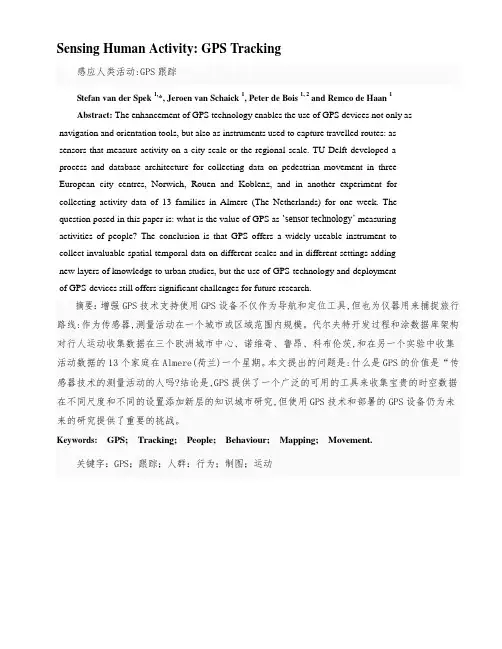
Sensing Human Activity:GPS Tracking感应人类活动:GPS跟踪Stefan van der Spek1,*,Jeroen van Schaick1,Peter de Bois1,2and Remco de Haan1Abstract:The enhancement of GPS technology enables the use of GPS devices not only as navigation and orientation tools,but also as instruments used to capture travelled routes:assensors that measure activity on a city scale or the regional scale.TU Delft developed aprocess and database architecture for collecting data on pedestrian movement in threeEuropean city centres,Norwich,Rouen and Koblenz,and in another experiment forcollecting activity data of13families in Almere(The Netherlands)for one week.Thequestion posed in this paper is:what is the value of GPS as‘sensor technology’measuringactivities of people?The conclusion is that GPS offers a widely useable instrument tocollect invaluable spatial-temporal data on different scales and in different settings addingnew layers of knowledge to urban studies,but the use of GPS-technology and deploymentof GPS-devices still offers significant challenges for future research.摘要:增强GPS技术支持使用GPS设备不仅作为导航和定位工具,但也为仪器用来捕捉旅行路线:作为传感器,测量活动在一个城市或区域范围内规模。
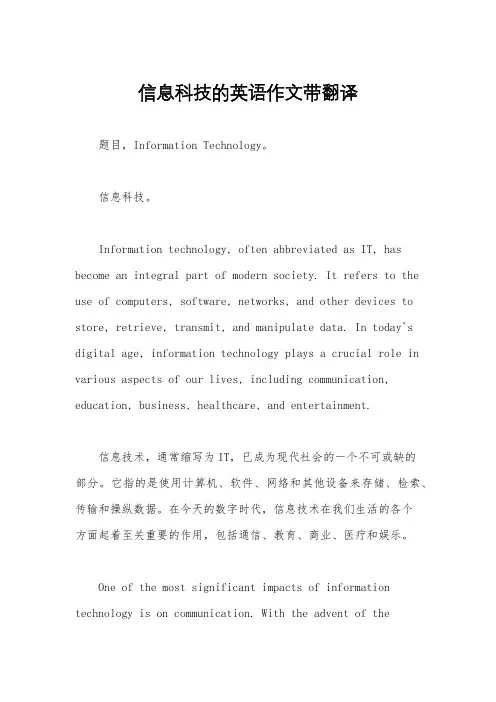
信息科技的英语作文带翻译题目,Information Technology。
信息科技。
Information technology, often abbreviated as IT, has become an integral part of modern society. It refers to the use of computers, software, networks, and other devices to store, retrieve, transmit, and manipulate data. In today's digital age, information technology plays a crucial role in various aspects of our lives, including communication, education, business, healthcare, and entertainment.信息技术,通常缩写为IT,已成为现代社会的一个不可或缺的部分。
它指的是使用计算机、软件、网络和其他设备来存储、检索、传输和操纵数据。
在今天的数字时代,信息技术在我们生活的各个方面起着至关重要的作用,包括通信、教育、商业、医疗和娱乐。
One of the most significant impacts of information technology is on communication. With the advent of theinternet, communication has become faster, easier, and more convenient than ever before. Email, instant messaging,social media platforms, and video conferencing have revolutionized the way people interact and exchange information. Distance is no longer a barrier to communication, as individuals from different parts of the world can connect in real-time through various online channels.信息技术最重要的影响之一是在通信方面。
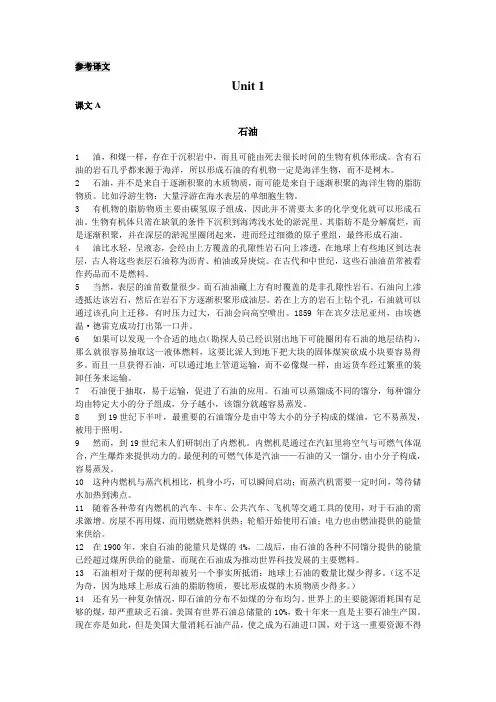
参考译文Unit 1课文A石油1油,和煤一样,存在于沉积岩中,而且可能由死去很长时间的生物有机体形成。
含有石油的岩石几乎都来源于海洋,所以形成石油的有机物一定是海洋生物,而不是树木。
2 石油,并不是来自于逐渐积聚的木质物质,而可能是来自于逐渐积聚的海洋生物的脂肪物质。
比如浮游生物:大量浮游在海水表层的单细胞生物。
3 有机物的脂肪物质主要由碳氢原子组成,因此并不需要太多的化学变化就可以形成石油。
生物有机体只需在缺氧的条件下沉积到海湾浅水处的淤泥里。
其脂肪不是分解腐烂,而是逐渐积聚,并在深层的淤泥里圈闭起来,进而经过细微的原子重组,最终形成石油。
4 油比水轻,呈液态,会经由上方覆盖的孔隙性岩石向上渗透,在地球上有些地区到达表层,古人将这些表层石油称为沥青、柏油或异庚烷。
在古代和中世纪,这些石油油苗常被看作药品而不是燃料。
5 当然,表层的油苗数量很少。
而石油油藏上方有时覆盖的是非孔隙性岩石。
石油向上渗透抵达该岩石,然后在岩石下方逐渐积聚形成油层。
若在上方的岩石上钻个孔,石油就可以通过该孔向上迁移。
有时压力过大,石油会向高空喷出。
1859年在宾夕法尼亚州,由埃德温·德雷克成功打出第一口井。
6 如果可以发现一个合适的地点(勘探人员已经识别出地下可能圈闭有石油的地层结构),那么就很容易抽取这一液体燃料,这要比派人到地下把大块的固体煤炭砍成小块要容易得多。
而且一旦获得石油,可以通过地上管道运输,而不必像煤一样,由运货车经过繁重的装卸任务来运输。
7 石油便于抽取,易于运输,促进了石油的应用。
石油可以蒸馏成不同的馏分,每种馏分均由特定大小的分子组成,分子越小,该馏分就越容易蒸发。
8 到19世纪下半叶,最重要的石油馏分是由中等大小的分子构成的煤油,它不易蒸发,被用于照明。
9 然而,到19世纪末人们研制出了内燃机。
内燃机是通过在汽缸里将空气与可燃气体混合,产生爆炸来提供动力的。
最便利的可燃气体是汽油——石油的又一馏分,由小分子构成,容易蒸发。
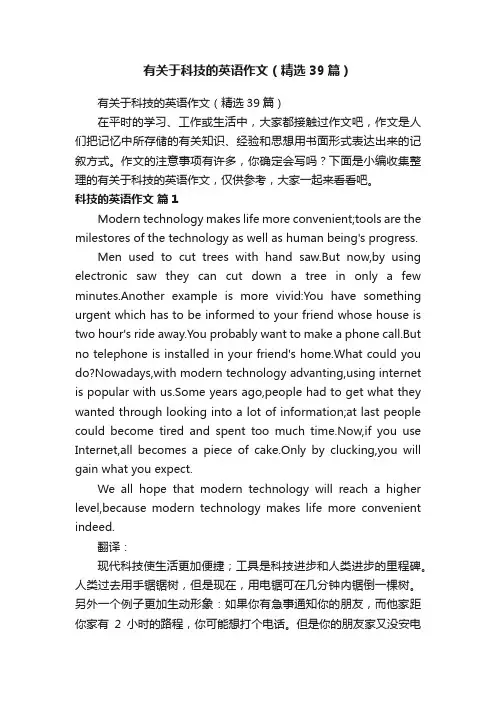
有关于科技的英语作文(精选39篇)有关于科技的英语作文(精选39篇)在平时的学习、工作或生活中,大家都接触过作文吧,作文是人们把记忆中所存储的有关知识、经验和思想用书面形式表达出来的记叙方式。
作文的注意事项有许多,你确定会写吗?下面是小编收集整理的有关于科技的英语作文,仅供参考,大家一起来看看吧。
科技的英语作文篇1Modern technology makes life more convenient;tools are the milestores of the technology as well as human being's progress.Men used to cut trees with hand saw.But now,by using electronic saw they can cut down a tree in only a few minutes.Another example is more vivid:You have something urgent which has to be informed to your friend whose house is two hour's ride away.You probably want to make a phone call.But no telephone is installed in your friend's home.What could you do?Nowadays,with modern technology advanting,using internet is popular with us.Some years ago,people had to get what they wanted through looking into a lot of information;at last people could become tired and spent too much time.Now,if you use Internet,all becomes a piece of cake.Only by clucking,you will gain what you expect.We all hope that modern technology will reach a higher level,because modern technology makes life more convenient indeed.翻译:现代科技使生活更加便捷;工具是科技进步和人类进步的里程碑。
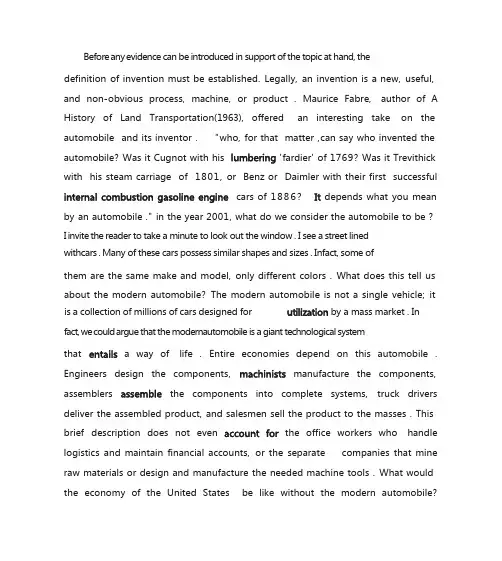
Before any evidence can be introduced in support of the topic at hand, thedefinition of invention must be established. Legally, an invention is a new, useful, and non-obvious process, machine, or product . Maurice Fabre, author of A History of Land Transportation(1963), offered an interesting take on the automobile and its inventor . "who, for that matter ,can say who invented thewith his steam carriage of 1801, or Benz or Daimler with their first successfulcars of 1886?depends what you meanby an automobile ." in the year 2001, what do we consider the automobile to be ?I invite the reader to take a minute to look out the window . I see a street linedwithcars . Many of these cars possess similar shapes and sizes . Infact, some ofthem are the same make and model, only different colors . What does this tell us about the modern automobile?The modern automobile is not a single vehicle;itfact, we could argue that the modernautomobile is a giant technological systemthatEngineers design the components,manufacture the components,assemblers the components into complete systems,truck driversdeliver the assembled product, and salesmen sell the product to the masses . This brieflogistics and maintain financial accounts,or the separate companies that mine raw materials or design and manufacture the needed machine tools . What would the economy of the United States be like without the modern automobile?Obviously, the modernautomobile and self propelled vehicle are necessarily thesame .翻译:在任何证据被介绍来支持这个主题以前,必须建立发明的定义。
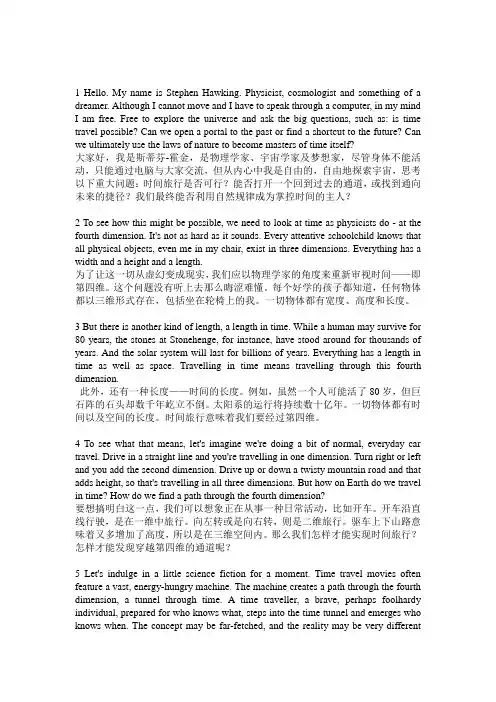
1 Hello. My name is Stephen Hawking. Physicist, cosmologist and something of a dreamer. Although I cannot move and I have to speak through a computer, in my mind I am free. Free to explore the universe and ask the big questions, such as: is time travel possible? Can we open a portal to the past or find a shortcut to the future? Can we ultimately use the laws of nature to become masters of time itself?大家好,我是斯蒂芬-霍金,是物理学家、宇宙学家及梦想家,尽管身体不能活动,只能通过电脑与大家交流,但从内心中我是自由的,自由地探索宇宙,思考以下重大问题:时间旅行是否可行?能否打开一个回到过去的通道,或找到通向未来的捷径?我们最终能否利用自然规律成为掌控时间的主人?2 To see how this might be possible, we need to look at time as physicists do - at the fourth dimension. It's not as hard as it sounds. Every attentive schoolchild knows that all physical objects, even me in my chair, exist in three dimensions. Everything has a width and a height and a length.为了让这一切从虚幻变成现实,我们应以物理学家的角度来重新审视时间——即第四维。
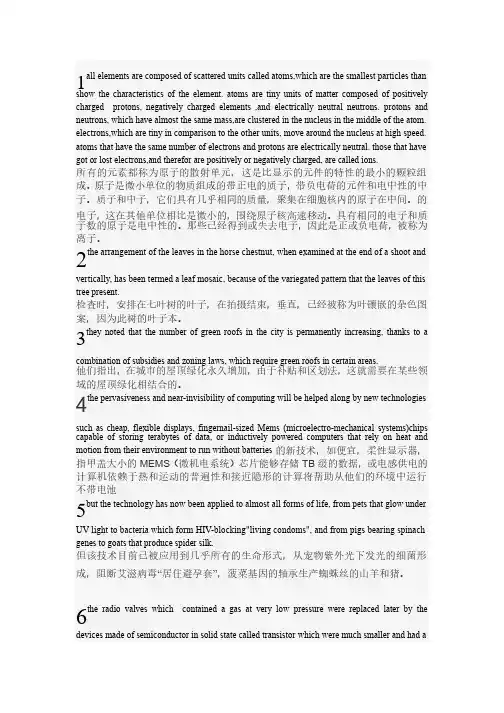
1all elements are composed of scattered units called atoms,which are the smallest particles than show the characteristics of the element. atoms are tiny units of matter composed of positively charged protons, negatively charged elements ,and electrically neutral neutrons. protons and neutrons, which have almost the same mass,are clustered in the nucleus in the middle of the atom. electrons,which are tiny in comparison to the other units, move around the nucleus at high speed. atoms that have the same number of electrons and protons are electrically neutral. those that have got or lost electrons,and therefor are positively or negatively charged, are called ions.所有的元素都称为原子的散射单元,这是比显示的元件的特性的最小的颗粒组成。
原子是微小单位的物质组成的带正电的质子,带负电荷的元件和电中性的中子。
质子和中子,它们具有几乎相同的质量,聚集在细胞核内的原子在中间。
的电子,这在其他单位相比是微小的,围绕原子核高速移动。
具有相同的电子和质子数的原子是电中性的。
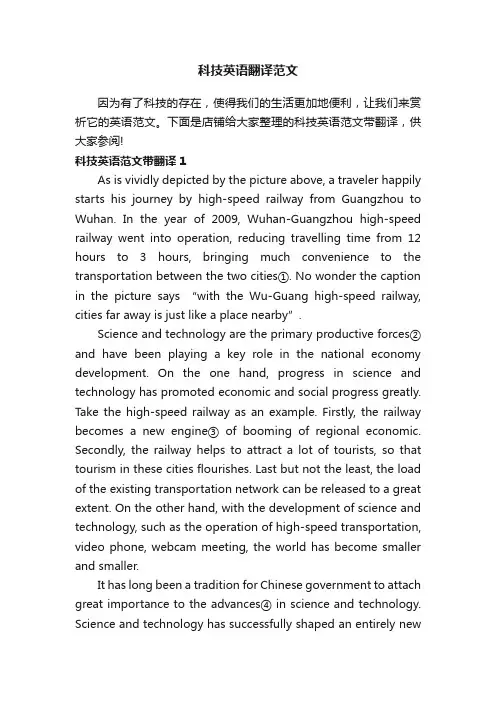
科技英语翻译范文因为有了科技的存在,使得我们的生活更加地便利,让我们来赏析它的英语范文。
下面是店铺给大家整理的科技英语范文带翻译,供大家参阅!科技英语范文带翻译1As is vividly depicted by the picture above, a traveler happily starts his journey by high-speed railway from Guangzhou to Wuhan. In the year of 2009, Wuhan-Guangzhou high-speed railway went into operation, reducing travelling time from 12 hours to 3 hours, bringing much convenience to the transportation between the two cities①. No wonder the caption in the picture says “with the Wu-Guang high-speed railway, cities far away is just like a place nearby”.Science and technology are the primary productive forces② and have been playing a key role in the national economy development. On the one hand, progress in science and technology has promoted economic and social progress greatly. Take the high-speed railway as an example. Firstly, the railway becomes a new engine③ of booming of regional economic. Secondly, the railway helps to attract a lot of tourists, so that tourism in these cities flourishes. Last but not the least, the load of the existing transportation network can be released to a great extent. On the other hand, with the development of science and technology, such as the operation of high-speed transportation, video phone, webcam meeting, the world has become smaller and smaller.It has long been a tradition for Chinese government to attach great importance to the advances④ in science and technology. Science and technology has successfully shaped an entirely newimage of China on global stage via the two grand world events, 2008 Olympic Games and 2010 Shanghai World Expo. It is strongly advised that young people should devote themselves into the study of science and technology for “better city, bet ter life”.佳作妙译如上图所示,一位旅客从广州踏上了去往武汉的高速铁路.2009年,武广高铁正式建成通车,将两地之间的行程从12小时缩短到3小时,极大地方便了两地的交通.难怪这幅漫画上写道“有了武广高铁,每个城市都在家门口”.科技是第一生产力,在国民经济发展中扮演着重要角色.一方面,科技的进步促进了经济社会的快速进步.高速铁路就是鲜活的例子.首先这条铁路成为地区经济发展新的引擎.其次铁路吸引了大量游客,这些城市的旅游业随之繁荣起来.再次这条铁路很大程度上缓解了现有线路的运输压力.另一方面,随着科技的发展,高速铁路,视频电话,视频会议等应用会越来越多,世界将变得越来越小.中国政府一直很重视科技的发展,通过2008北京奥运会和2010上海世博两件盛事,科技成功地重塑了中国在世界舞台上的国际形象.因此青少年要怀着“城市,让生活更美好”的信念,积极投身到对科技文化知识的学习上.科技英语范文带翻译2Modern technology makes life more convenient; tools are the milestores of the technology as well as hu man being’ s progress.Men used to cut trees with hand saw. But now, by using electronic saw they can cut down a tree in only a few minutes. Another example is more vivid: You have something urgent which has to be informed to your friend whose house is two hour’s ride away. You probably want to make a phone call. But no telephone is installed in your friend’ s home. What could youdo? Nowadays, with modern technology advanting, using internet is popular with us. Some years ago, people had to get what they wanted through looking into a lot of information; at last people could become tired and spent too much time. Now, if you use Internet, all becomes a piece of cake. Only by clucking, you will gain what you expect.We all hope that modern technology will reach a higher level, because modern technology makes life more convenient indeed.[参考译文]现代科技使生活更加便捷现代科技使生活更加便捷;工具是科技进步和人类进步的里程碑.人类过去用手锯锯树,但是现在,用电锯可在几分钟内锯倒一棵树.另外一个例子更加生动形象:如果你有急事通知你的朋友,而他家距你家有2小时的路程,你可能想打个电话.但是你的朋友家又没安电话,你该怎么办?如今,随着现代科技的进步,使用网络已很流行.若干年前,人们不得不查找大量资料来搜集需要的信息,最后人累得疲惫不堪,还浪费了大量时间.现在,如果使用网络,一切就都是小菜一碟了.只要轻敲键盘,就会有求必应.我们都期待着现代科技能达到一个更高的水平,因为现代科技确实使生活变得更便捷.科技英语范文The development of science and technology makes our life more comfortable and convenient. However, scientists have created many problems, which are not easy to be resolved, such as air pollution, the deterioration of environment and the scarcity of natural resources, to which we must some solutions.Modern science and technology render people many advantages. Modern telecommunication shortens the distance between people and makes communication much easier. Internet is widely used now not only for collection of abundantinformation but also for correspondence. Email, the most effective communication device now, is becoming very popular. Besides, telephone and mobile phone make contact more convenient than before.Modern transportation, such as airplanes and high-speed trains make our journey smooth and fast. With the help of modern transportation, people can go everywhere they prefer to. The journey to outer space and other planets is not a dream any more. Rockets and space shuttles can help us realize the dream of space travel.Modern medicine prolongs peoples life and relieves patients of sufferings from many diseases. Cancer and AIDS are fatal to peoples health. Thanks to the endeavors scientists have made, these diseases become treatable.However, the process of scientific development also arouses many sever problems to our human beings. Internet, though widely used in modern communication, is easy to be destroyed by computer virus. Outer space exploration has produced much waste in the space. A tiny metal, a screw, for example can destroy a flying man-made satellite. Industrialization is making natural resources become scarce.Confronted with these problems, scientists are seeking prompt and feasible solutions. The development of science and technology bring about both positive and negative effects to us. We must eliminate the positive effects to the least extent.。
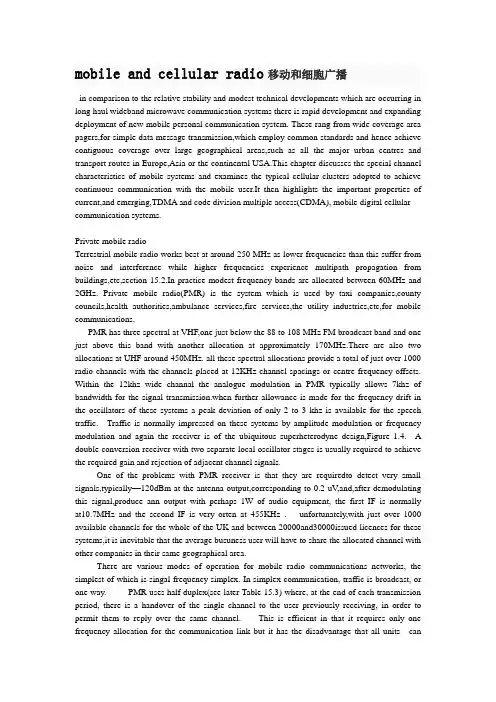
mobile and cellular radio移动和细胞广播in comparison to the relative stability and modest technical developments which are occurring in long haul wideband microwave communication systems there is rapid development and expanding deployment of new mobile personal communication system. These rang from wide coverage area pagers,for simple data message transmission,which employ common standards and hence achieve contiguous coverage over large geographical areas,such as all the major urban centres and transport routes in Europe,Asia or the continental USA.This chapter discusses the special channel characteristics of mobile systems and examines the typical cellular clusters adopted to achieve continuous communication with the mobile user.It then highlights the important properties of current,and emerging,TDMA and code division multiple access(CDMA), mobile digital cellular communication systems.Private mobile radioTerrestrial mobile radio works best at around 250 MHz as lower frequencies than this suffer from noise and interference while higher frequencies experience multipath propagation from buildings,etc,section 15.2.In practice modest frequency bands are allocated between 60MHz and 2GHz. Private mobile radio(PMR) is the system which is used by taxi companies,county councils,health authorities,ambulance services,fire services,the utility industries,etc,for mobile communications.PMR has three spectral at VHF,one just below the 88 to 108 MHz FM broadcast band and one just above this band with another allocation at approximately 170MHz.There are also two allocations at UHF around 450MHz. all these spectral allocations provide a total of just over 1000 radio channels with the channels placed at 12KHz channel spacings or centre frequency offsets. Within the 12khz wide channal the analogue modulation in PMR typically allows 7khz of bandwidth for the signal transmission.when further allowance is made for the frequency drift in the oscillators of these systems a peak deviation of only 2 to 3 khz is available for the speech traffic. Traffic is normally impressed on these systems by amplitude modulation or frequency modulation and again the receiver is of the ubiquitous superheterodyne design,Figure 1.4. A double conversion receiver with two separate local oscillator stages is usually required to achieve the required gain and rejection of adjacent channel signals.One of the problems with PMR receiver is that they are requiredto detect very small signals,typically—120dBm at the antenna output,corresponding to 0.2 uV,and,after demodulating this signal,produce ann output with perhaps 1W of audio equipment, the first IF is normally at10.7MHz and the second IF is very orten at 455KHz . unfortunately,with just over 1000 available channels for the whole of the UK and between 20000and30000issued licences for these systems,it is inevitable that the average busuness user will have to share the allocated channel with other companies in their same geographical area.There are various modes of operation for mobile radio communications networks, the simplest of which is singal frequency simplex. In simplex communication, traffic is broadcast, or one way. PMR uses half duplex(see later Table 15.3) where, at the end of each transmission period, there is a handover of the single channel to the user previously receiving, in order to permit them to reply over the same channel. This is efficient in that it requires only one frequency allocation for the communication link but it has the disadvantage that all units canhear all transmissions provided they are within rage of the mobile and frequencies are allocated for the transmissions. One frequency is used for the forward or downlink, namely base-to-mobile communications. This permits simultaneous two-way communication and greatly reduces the level of interference, but it halves other’s transmissions, which can lead to contention with two mobiles attempting to initiate a call, at the same time, on the uplink in a busy syetem.Although PMR employs relatively simple techniques with analogue speech transmission there have been many enhancements to these systems over the years . Data transmission is now in widespread use in PMR systems using FSK modulation. Data transmission also allows the possibility of hard copy graphics output and it gives direct access to computer services such as databases, etc. Data prembles can also be used, in a selective calling mode, when initiating a transmission to address a special receiver and thus obtain more privacy within the system.15.4.5 Trunked radio for paramilitary use集群无线电的军事使用Another related TDMA mobile radio standard is the European trunked radio(TETRA)network which has been developed as part of the public safety radio communications service(PSRCS) for use by police, utilities, customs office, etc. TETRA in fact is part of wider international collaborations for paramilitary radio use.In these portable radios there is a need for frequency hopping (FH) to give an antieavesdropping capability and encryption for security of transmission to extend military mobile radio capabilities to paramilitary use, i.e. for police, customs and excise offices, etc. these capabilities are included in the multiband interteam radio for the associated public safety communications office in the USA while Europe has adopted the TETRA standard.TETRA is essentially the digital TDMA replacement of the analogue PMR systems. The TETRA standard has spectrum allocations of 380 to 400 and 410 to 430MHz, with the lower band used for mobile transmissions and the upper band for base station use. TETRA mobile have 1 W output power and the base stations 25 W using error with the data throughput rate varying, to meet the required quality of service. TETRA can accommodate up to four users each with a basic speech or data rate of 7.2kbit/s. with coding and signaling overheads, the final transmission rate for the four-user slot is 36 kbit/s. this equipment is large and more sophisticated than a commercial cell phone, and it sells for a very much higher price becase the production runs are much small. However, its advanced capabilities are essential for achieving paramilitary communications which are secure from eavesdropping.15.5 Code division multiple accessAnalogue communication systems predominantly adopt frequency division multiple access (FDMA), where each subscriber is allocated a narrow frequency slot within the available channel. The alternative TDMA(GSM) technique allocates the entire channel bandwidth to a subscriber but constrains the subscriber but constrains the subscriber to transmit only regular short bursts of wideband signal. Both these accessing techniques are well established for long haulterrestrial, satellite and mobile communications as they offer very good utilization of the available bandwidth.15.5.1The inflexibility of these coordinated accessing techniques has resulted in the development of new systems based on the uncoordinated spread spectrum concept. In these systems the bits of slow speed data traffic from each subscriber are deliberately multiplied by a high chip rate spreading code, forcing the low rate (narrowband data signal) to fill a wide channel bandwidth.15.7.2 3G systemsThe evolution of the third generation (3G)system began when the ITU produce the initial recommendations for a new universal mobile telecommunications system(UMTS)[www.] The 3G mobile radio service provides higher data rate services ,with a maximum data rate in excess of 2Mbit/s, but the achievable bit rate is linked to mobility. Multimedia applications encompass services such as voice, audio/video, graphics, data, Internet access and e-mail. These packet and circuit switched services have to be supported by the radio interface and the network subsystem.Several radio transmission technologies(RTT) were evaluated by the ITU and adopted into the new standard, IMT-2000. the European standardization body for 3G, the ETSI Special Mobile Group, agreed on a radio access scheme for 3G UMTS universal terrestrial radio access(UTRA) as an evolution of GSM. UTRA consists of two modes : frequency division duplex(FDD) where the uplink and downlink are transmitted on different frequencies; and time division duplex(TDD) where the uplink and downlink are time multiplexed onto the same carrier frequency. The agreement assigned the unpaired bands (i.e. for UTRA TDD ). TD-CDMA is a pure CDMA based system. Both modes of UTRA have been harmonised with respect to basic system parameters such as carrier spacing, chip rate and frame length to ensure the interworking of UTRA with GSM.The 3G proposal were predominantly based wideband CDMA(WCDMA) and a mix of FDD and TDD access techniques. WCDMA is favoured for 3G in poor propagation environments with a mix of high modest speed data traffic. It is generally accepted that CDMA is the preferred accesstechnique and, with the increase in the data rate, then the spreading modulation needs to increase to wideband transmission.WCDMA is based on 3.84Mchip/s spreading codes with spreading ratio, i.e. , K values, of 4-256 giving corresponging data ratas of 960-15 kbit/s. the upper FDD uplink band I from 1920-1980 MHz is paired with a 2110-2170 MHz downlink. In addition uplink bands II & III at 1850-1910 MHz and 1710-1785 MHz are also paired, respectively, with 1930-1990 MHz and 1805-1880 MHz allocations. the system is configured on a 10 ms frame with 15 individual slots to facilitate TDD as well as FDD transmissions. TDD is more flexible as time-slots can be dynamically reassigned to uplink and downlink functions, as required for asymmetric transfer of large files or video on demand traffic. 3G WCDMA systems use an adaptive multirate speech coder with encoded rates of 4.75-12.2 kbit/s. receivers commonly use the easily integrated direct conversion design, in place of the superheterodyne design . receiver sensitivities are typically -155dBm.The 3GPP2 standard aims to achieve a wide area mobile wireless packet switched capability with CDMA2000 1×EV DO revision A (sometimes called IS-856A). Here 1×refers to the single carrier 1.25 Mchip/s system. It achieves a 3.1 Mbit/s downlink and a delay sensitive services. The 3GPP standard has gone through many release with R4 in 2001 which introduced packet data services and R6 in 2005 to further increase the available data transmission rate . R6 pioneers the use of high-speed downlink packet access and multimedia broadcast multicast services which offer reduced delays and increased uplink data rates approaching 6 Mbit/s.In parallel with the European activities extensive work on 3G mobile radio was also performed in Japan. The Japanese standardisation body also chose WCDMA, so that the Japanese and European proposals for the FDD mode were already aligned closely. Very similar concepts have also been adopted by the North American standardization body.In order to work towards a global 3G mobile radio standard, the third generation partnership project(3GPP), consisting of members of the standardization bodies in Europe, the USA, Japan, Korea and China, was formed. It has merged the already well harmonized proposals of the regional standardization bodies to work on a common 3G international mobile radio standard, still called UTRA. The 3GPP Project 2(3GPP2), on the other hand, works towards a 3G mobile radio standard based on cdmaOne/IS-95 evolution, originally called CDMA2000.比起相对稳定、适度的技术发展是发生在宽带微波通信系统,有长期快速发展和扩大部署的新的移动个人通讯系统。
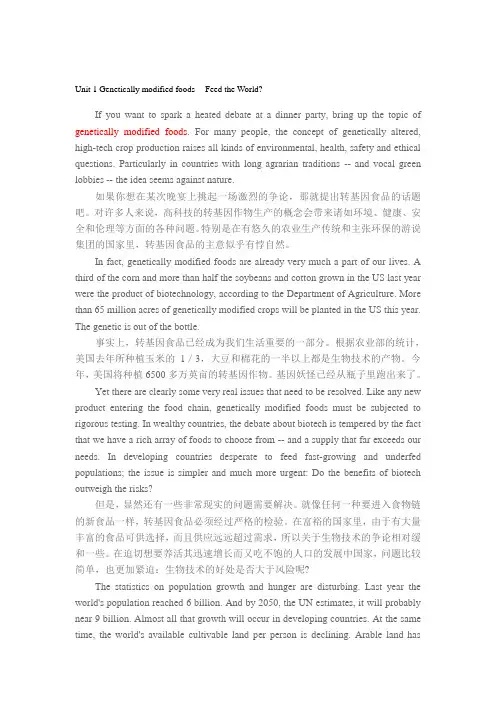
Unit 1 Genetically modified foods -- Feed the World?If you want to spark a heated debate at a dinner party, bring up the topic of genetically modified foods. For many people, the concept of genetically altered, high-tech crop production raises all kinds of environmental, health, safety and ethical questions. Particularly in countries with long agrarian traditions -- and vocal green lobbies -- the idea seems against nature.如果你想在某次晚宴上挑起一场激烈的争论,那就提出转基因食品的话题吧。
对许多人来说,高科技的转基因作物生产的概念会带来诸如环境、健康、安全和伦理等方面的各种问题。
特别是在有悠久的农业生产传统和主张环保的游说集团的国家里,转基因食品的主意似乎有悖自然。
In fact, genetically modified foods are already very much a part of our lives. A third of the corn and more than half the soybeans and cotton grown in the US last year were the product of biotechnology, according to the Department of Agriculture. More than 65 million acres of genetically modified crops will be planted in the US this year. The genetic is out of the bottle.事实上,转基因食品已经成为我们生活重要的一部分。
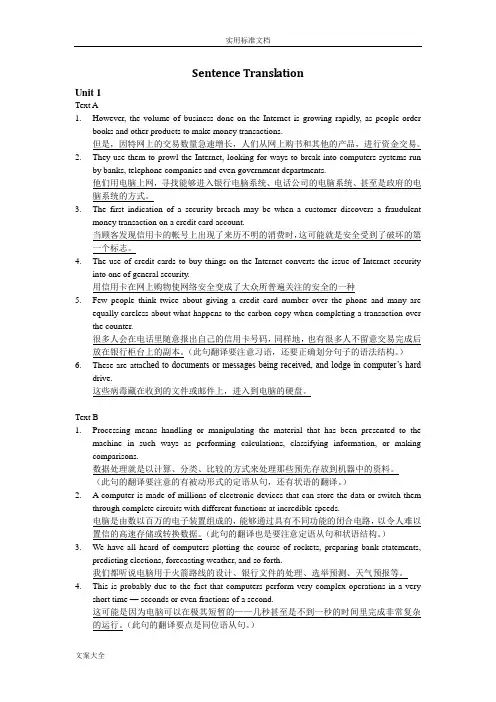
Sentence TranslationUnit 1Text A1.However, the volume of business done on the Internet is growing rapidly, as people orderbooks and other products to make money transactions.但是,因特网上的交易数量急速增长,人们从网上购书和其他的产品,进行资金交易。
2.They use them to prowl the Internet, looking for ways to break into computers systems runby banks, telephone companies and even government departments.他们用电脑上网,寻找能够进入银行电脑系统、电话公司的电脑系统、甚至是政府的电脑系统的方式。
3.The first indication of a security breach may be when a customer discovers a fraudulentmoney transaction on a credit card account.当顾客发现信用卡的帐号上出现了来历不明的消费时,这可能就是安全受到了破坏的第一个标志。
4.The use of credit cards to buy things on the Internet converts the issue of Internet securityinto one of general security.用信用卡在网上购物使网络安全变成了大众所普遍关注的安全的一种5.Few people think twice about giving a credit card number over the phone and many areequally careless about what happens to the carbon copy when completing a transaction over the counter.很多人会在电话里随意报出自己的信用卡号码,同样地,也有很多人不留意交易完成后放在银行柜台上的副本。
In the realm of technology,English has become an essential language for communication and documentation.When translating English compositions related to technology,it is crucial to maintain the precision and technical accuracy that the field demands.Here are some key aspects to consider when translating a technologythemed English essay into another language:1.Technical Vocabulary:Ensure that all technical terms are translated accurately. Mistranslations can lead to confusion and misinterpretation of the content.2.Consistency:Maintain consistency in the translation of key terms and concepts throughout the essay to avoid ambiguity.3.Contextual Understanding:A deep understanding of the context in which the technology is discussed is necessary.This helps in choosing the right words and phrases that accurately convey the intended meaning.4.Cultural Adaptation:While translating,its important to consider cultural differences that might affect the interpretation of certain concepts or terms.5.Precision and Clarity:The translation should be precise and clear,avoiding any ambiguity that could arise from a literal translation.6.Preserve the Structure:The structure of the original essay should be preserved as much as possible to maintain the flow of ideas and arguments.e of Appropriate Language:The language used in the translation should be appropriate for the target audience.Technical jargon should be used where necessary,but also consider the level of understanding of the reader.8.Proofreading:After the translation is complete,it should be proofread for any grammatical errors,typos,or inconsistencies.9.Feedback:It can be beneficial to have the translation reviewed by a native speaker or a subject matter expert to ensure accuracy and comprehension.10.Software and Tools:Utilize translation software and tools to assist with the translation process,but always doublecheck the output for accuracy and context.Remember,the goal of translating a technology essay is not just to convert words fromone language to another,but to convey the same level of understanding and insight that the original text provides.。
第三单元动植物植物的适应性植物为了生存也必须像人类和动物一样适应周边的环境。
生存就意味着竞争,我们很难想象植物之间的竞争,但它往往又存在的。
首先,不同的植物之间会争夺阳光、空气、土壤和水。
其次,植物也会与那些吃它或者威胁到它生存环境的人类和动物竞争。
再次,植物所处的环境也可能也是有敌对性的或者不利于植物生长的。
怎样才能有足够的阳光、水分、空气和土壤?气温的冷热就是植物生长的主要因素吗?光对于植物来说是最基本的,尤其是对于绿色植物来说。
绿色植物在光下能制造养分——这是一种被称为光合作用的过程,而光也能影响水分蒸发的速率和花的形成。
温度也是必须考虑的因素。
对于大多数植物来说,所处的温度低于一度或者高于四十三度都将对其造成严重的损伤甚至死亡。
而温度也直接影响了种子的萌芽以及开花,当然温度也决定了它们的地理分布。
没有水植物也是无法生存的。
有些植物的生长过程需要大量的水分,因此潮湿的空气、大量的降水以及溪流湖泊和湿润的土壤对于植物都是重要的。
大多数植物需要有足够空气。
大气中所包含的一些必要的气体包括:氧气、二氧化碳、水蒸气和氮气。
空气移动所产生的风对于植物也有很大影响。
风有助于传播花粉、孢子和种子从而将它们播种在各种地方,但强风也有可能折断或者损害植物,尤其是大树。
而大风吹走了一些有养分的土壤,也会加快水分的蒸发甚至使植物缺水。
土壤对于陆生植物来说是必不可少的。
大部分植物生长在自然土壤里:其中包含着它的湿度、酸度、矿物成分、含氧量。
植物生长也会受到其他竞争生物的影响。
它必须能适应寄生菌、饥饿的鸟类、牛羊等食用叶子的动物,但植物也需要动物帮助传播花粉以及播洒种子。
有树叶和枝干的树以及灌木向我们展示了它们的适应性,这也告诉了我们植物是怎样获得最大量的光和空气的。
和那些山毛榉树、榆树、橡树、苹果树和栗子树一样,它们有一些芽最初是垂直生长的然而另一些却变成了水平生长。
为了能得到最多的阳光,一些垂直生长的枝芽会螺旋缠绕生长以至于不会遮挡到自己下边的叶子。
第一单元自动化第二部分阅读A自动化的含义“自动化”已经是,而且现在仍然是,一个被大量滥用的词。
但是,人们对其确切的意义以及所包括的内容,正在逐渐地有了较为正确的了解。
如果不是下一个定义的话,我也许可以尝试作些解释,把自动化说成是一个概念。
运用这个概念,人们通过对机器装置的性能进行充分的测量、观察和控制,从而使其以最高的效率运转。
这需要对这种装置的功能有一个详细而连贯性的了解,以便需要时便能运用最佳的矫正操作。
自动化按其确切的意义,只有全面运用通信、计算和控制三个主要组成部分(“三C" )才能完全实现。
我认为,确保人们对合为一体的三个组成部分对我们的社会所蕴含着的某些意义有所认识和了解,是很有必要的。
首先,我们不妨考虑工业部门之一的炼钢工业。
在炼钢工业中,自动化已经开始成型。
到过钢厂的人都会知道从高炉开始的各种工艺流程的一些情况,成品条钢或板钢生产出来之后,再准备送往制造工艺车间或汽车厂,这些工艺流程是相互链接的。
为了使工厂中各个车间充分发挥效率,可以使用计算机来控制每个车间。
在此之前,计算机工作所需要的一切资料均输入机内。
就高炉来说,需要给计算机提供装人高炉的原料的信息、高炉工作温度的信息和处理各种各样配料的最好方法等方面的资料。
钢厂的高炉操作是一项复杂而要求技术熟练的作业,需要大量的知识和大量的综合信息,并迅速地做出判定选择,以便确保高炉工艺流程中的下一阶段的有效工作。
计算机对所有这一切都了解得很透彻,能够做出非常大量的中间判定,并且能够把全部信息立刻和不间断地提供给管理人员,以使他们做出高效管理这个工厂所需要的最后决定。
由此产生的信息数据和判定要进行处理,然后转送到下一个工序。
在这里,对操作的一些专门细节再次进行整理,提出最佳和最终的判定,然后对这些信息再一次进行处理并输送给下一道工序。
同时,当信息数据从生产单元的一道工序输送到下一工序并完全结合成为一项新的操作时,每次变化的结果反馈到最初阶段,而且,不断地做进一步的调整,结果是整个工厂的工艺流程便能够高效率地进行下去。
英文科技专题文章范文(热门3篇)英文科技专题文章范文第1篇One way to get noticed is Reuben Smith Vaughn, another American college graduate. The most popular majors in this university are English, business and economics. Sitting here, he hears the real Emptiness: Bachelor's degree or above, major in machinery or trade.Our textbook is new international business English published by Cambridge University Press. How do you deal with training, becoming a celebrity and homework? I'm Li San from Jiujiang. I'm a fresh graduate majoring in Business English, with bachelor's degree or above in mining or business English Mechanical or business majors give priority to college education with Japanese as major, plus practical experience in translating business documents for homework.Write a letter to your parents and tell them about your life in college,.中文翻译:一个能引起注意的方法是鲁本·史密斯·沃恩,另一个美国大学的毕业生。
核电与核辐射1986年4月26日,切尔诺贝利核电站的一个反应堆发生爆炸,将相当于400颗广岛原子弹的放射性尘降物散布到整个北半球。
在此之前,科学家对辐射对植物和野生动物的影响几乎一无所知。
这场灾难创造了一个活生生的实验室,尤其是在这个被称为禁区的1100平方英里的区域。
1994年,德州理工大学生物学教授罗纳德·切瑟和罗伯特·贝克是首批获准完全进入该区域的美国科学家之一。
“我们抓了一群田鼠,它们看起来和野草一样健康。
我们对此非常着迷。
”贝克回忆说。
当Baker和Chesser对田鼠的DNA进行测序时,他们没有发现异常的突变率。
他们还注意到狼、猞猁和其他曾经稀有的物种在这片区域游荡,仿佛这里是原子野生动物保护区。
2003年由一组联合国机构建立的切尔诺贝利论坛发表了声明一份关于灾难20周年的报告证实了这一观点,称“环境条件对该地区的生物群落产生了积极影响”,将其转变为“一个独特的生物多样性保护区”。
五年前,贝克和切塞尔在这片区域搜寻田鼠。
Mousseau到切尔诺贝利去数鸟,发现了与之相矛盾的证据。
穆萨乌是南卡罗莱纳大学的生物学教授,他的合作者安德斯·佩普·穆勒现在是巴黎南方大学生态、系统学和进化实验室的研究主任。
他们发现该地区家燕的数量要少得多,而那些存活下来的家燕则遭受着寿命缩短、(雄性)生育能力下降、大脑变小、肿瘤、部分白化病(一种基因突变)以及白内障发病率更高的痛苦。
在过去13年发表的60多篇论文中,Mousseau和Moller指出,暴露在低水平辐射下对该区域的整个生物圈产生了负面影响,从微生物到哺乳动物,从昆虫到鸟类。
包括贝克在内的批评人士对穆萨和穆勒持批评态度。
贝克在2006年与切塞尔合著的《美国科学家》(American Scientist)文章中指出,该区域“实际上已成为一个保护区”,穆萨和穆勒的“令人难以置信的结论只得到了间接证据的支持”。
我们所知道的关于电离辐射对健康影响的几乎所有信息都来自于一项正在进行的对原子弹幸存者的研究,该研究被称为寿命研究,简称LSS。
Unit1 text A福岛的燕子我们对低剂量辐射对生物体和生态系统的影响知之甚少。
福岛核灾难四年后,科学家们开始得到一些答案。
By Steven Featherstone 直到1986年4月26日切洛贝利核电站的一个反应堆发生爆炸,在整个北半球扩散了相当于400枚广岛核弹的辐射尘,对于辐射对植被和野生动物的影响科学家几乎一无所知。
这场灾难创造了一个活生生的实验室,特别是在爆炸地点周围1100平方英里的地方,被称为禁区。
1994年,德克萨斯理工大学生物学教授罗纳德·切斯尔(Ronald Chesser)和罗伯特·贝克(Robert Baker)都是首批获准进入该区域的美国科学家。
我们抓到了一群田鼠,它们看起来像杂草一样健康。
贝克回忆说:“我们开始对它着迷。
当贝克和切斯对田鼠的DNA进行测序时,他们没有发现异常突变率。
他们还注意到,狼、猞猁和其他曾经稀有的物种在该区域游荡,仿佛它是一个原子野生动物保护区。
切洛贝利论坛由联合国一些机构于2003年成立,发表了一份关于切洛贝利利灾难20周年的报告,证实了这一观点,声称“环境改变对该地区的生物群产生了积极影响”,将其转变为“一个独特的生物多样性保护区”。
在Baker和Chesser对该地区进行田鼠研究的五年后,Timothy A.Mousseau 前往切洛贝利对鸟类进行了计数,发现了相互矛盾的证据。
南卡罗来纳大学生物学教授穆索和他的合作者现任巴黎南部大学生态,系统学与进化实验室的研究主任-- Anders Pape Moller,特别的研究了常见的乡村谷仓燕(Hirundo Rustica)。
他们发现该地区的燕子少得多,幸存下来的燕子寿命较短,生育力降低(男性),大脑较小,肿瘤,部分白化病(一种基因突变)和白内障发生率较高。
Mousseau 和Moller在过去13年发表的60多篇论文中表明,暴露于低水平辐射对该区域的整个生物圈(从微生物到哺乳动物,从虫子到鸟类)都有负面影响。
Atomic clocks in space could detect gravitational waves
Clocks in space: narrowband gravitational-wave detector could take off. A proposal for a
gravitational-wave detector made of two space-based atomic clocks has been unveiled by
physicists in the US. The scheme involves placing two atomic clocks in different locations around
the Sun and using them to measure tiny shifts in the frequency of a laser beam shone from one
clock to the other. The designers claim that the detector will complement the LISA space-based
gravitational-wave detector, which is expected to launch in 2034.
Gravitational waves are ripples in the fabric of space–time that are created when masses are
accelerated. In February of this year, the LIGO collaboration announced the first-ever direct
detection of gravitational waves – from the merger of two black holes – using a pair of kilometer
-sized interferometers in the US. Just last week, a second detection was announced by LIGO from
a different black-hole merger.
Now, Shimon Kolkowitz and Jun Ye of JILA in Colorado have joined forces with Mikhail Lukin and
colleagues at Harvard University to come up with a proposal for detecting gravitational waves
using two space-based atomic clocks. Each device would be an optical-lattice atomic clock, which
is an extremely precise timekeeper that uses the frequency of an atomic transition to measure
time. The atoms are trapped within a 1D optical lattice that is a standing wave created by
reflecting laser light from a mirror. This is a very effective way of shielding the atoms from
external noise that can degrade clock performance.
译文:
在太空中的原子钟可以探测到引力波
太空中的时钟:窄带引力波探测器可以起飞。由两个空间原子钟制成的引力波探测器的提议
在美国的物理学家们已经公布了。该计划涉及到在太阳周围的不同位置放置两个原子钟,并
用它们来测量激光束在一个时钟到另一个时钟频率的微小变化。设计师们声称,探测器将补
充丽莎空间的引力波探测器,预计将于2034发射。
引力波是空间织物中的波纹,是当加速时产生的时间。在今年二月,LIGO合作宣布有史以
来第一次直接探测引力波的–从两个黑洞合并–双公里大小的干涉仪在美国。刚刚过去的一
周,第二检测宣布LIGO从不同的黑洞合并。
现在, Shimon Kolkowitz和Jun Ye在罗拉多州JILA联手与米哈伊尔卢金和同事在哈佛大学
拿出一个用两个太空原子钟探测引力波的建议。每个装置将光学晶格中的原子钟,这是一个
非常精确的计时器,利用测量时间的原子跃迁频率。原子被囚禁在一个一维的光晶格中,这
是一个由反射镜反射激光产生的驻波的驻波。这是一个非常有效的方法,屏蔽了从外部噪声,
可以降低时钟性能的原子。
在美国的物理学家们已经公布了由两个空间原子钟制成的引力波探测器的提议。该计划涉及
到在太阳周围的不同位置放置两个原子钟,并用它们来测量激光束在一个时钟到另一个时钟
频率的微小变化。设计师们声称,探测器将补充丽莎空间的引力波探测器,预计将于2034
发射。
翻译过程:
这篇文章是关于物理学太空原子钟的文章。考虑到翻译的严谨性,所以我选择的是英译汉。
在翻译的时候我是“由大到小,再由小及大”进行翻译。先从一个自然段到一个句子再到一
个单词的顺序进行翻译。首先,我先把这篇文章当中每一个自然段里的不认识的单词借助于
词典和工具书进行查阅,然后联系整个句子对词义进行选择,一个单词可能有好几种表达在
选择中文意思的时候,不能太拘泥于某单词常用意思。比如“Atomic clocks in space could
detect gravitational waves”译为“在太空中的原子钟可以探测到引力波”这个句子中的单词
“detect”,它有“查明,发现;洞察;侦察;侦查”的意思,可是在科技英语翻译当中,
这个单词译为这些意思似乎少了一点专业性,因为在物理学中,太空原子钟是被人所提出来
过,现在是人类在探查它,确定太空原子钟是否真的存在。所以,可译为“探测”